AC Breakdown Characteristics of c-C4F8/N2 Gas Mixtures in an Extremely Non-Uniform Electric Field
Abstract
:1. Introduction
2. Experimental Setup
2.1. Experimental Circuit
2.2. Electrode and Electric Field Simulation
2.3. Volume Fraction of Mixture
3. Results and Discussion
3.1. Breakdown Voltages of c-C4F8/N2 Mixture Changes with Pressure
3.2. Breakdown Voltages of c-C4F8/N2 Mixture Varying with Electrode Distance
3.3. Breakdown Voltages of c-C4F8/N2 Mixture Varying with Volume Fraction
3.4. Feasibility of Replacing SF6/N2 with c-C4F8/N2
4. Conclusions
- In an extremely non-uniform electric field, the breakdown voltages of 20%c-C4F8/80%N2 increase with the increase in pressure, electrode distance, and the volume fraction of c-C4F8. As the pressure increases, a “hump” occurs owing to the homogenization of an electric field through the corona. With the increase in electrode distance, the AC breakdown voltages of c-C4F8/N2 increase slightly in the case of a short gap, and increase significantly in the case of a long gap.
- Based on a comparison between SF6 and 20%SF6/80%N2, it was found that under the same conditions, the breakdown voltage of 20%c-C4F8/80%N2 can reach up to 46–90% that of 20%SF6/80%N2. At 0.3 MPa, the breakdown voltage of 20%c-C4F8/80%N2 can reach over 57% that of SF6.
- In an extremely non-uniform electric field, considering the insulation level and liquefaction temperature, a 20%c-C4F8/80%N2 mixture has the potential to replace SF6 in low- and medium-voltage equipment.
Author Contributions
Funding
Conflicts of Interest
References
- Luo, X.C. SF6 Gas-Insulated Switchgear; China Electric Power Press: Beijing, China, 1999; pp. 1–5. [Google Scholar]
- Christophorou, L.G.; Olthoff, J.K.; Van Brunt, R.J. Sulfur hexafluoride and the electric power industry. IEEE Electr. Insul. Mag. 1997, 13, 20–24. [Google Scholar] [CrossRef]
- Li, X.W.; Zhao, H. Review of research progress in SF6 substitute gases. High Volt. Eng. 2016, 42, 1695–1701. [Google Scholar] [CrossRef]
- Liang, F.J.; Wang, Y.Z.; Wang, L. The application situation of SF6 in electrical equipment and some problem. Insul. Mater. 2010, 43, 43–46. [Google Scholar]
- Qiu, Y.; Chalmers, I.D. Effect of surface roughness on breakdown in SF6-N2 and SF6-CO2 gas mixtures. J. Phys. D: Appl. Phys. 1993, 26, 28–36. [Google Scholar] [CrossRef]
- Zhang, R.; Wang, J.; Li, J. Insulation Characteristics of Environmentally Friendly Mix Gas c-C4F8/N2 Substituting SF6. High Volt. Eng. 2017, 43, 414–419. [Google Scholar] [CrossRef]
- Xiao, D.M. Gas Insulation and GIS; Shanghai Jiao Tong University Press: Shanghai, China, 2016; pp. 76–78. [Google Scholar]
- Tu, R.H. Introduction to United Nations framework convention on climate change and its Kyoto protocol and their negotiation process. Environ. Prot. 2005, 33, 65–71. [Google Scholar] [CrossRef]
- Xiao, D.M. Development Prospect of Gas Insulation based on Environmental Protection; IntechOpen: London, UK, 2018; pp. 1–6. [Google Scholar]
- Blodgett, F.W. Properties of octafluorocyclobutane, a dielectric gas. Trans. Am. Inst. Electr. Eng. Part I Commun. Electron. 1959, 78, 63–66. [Google Scholar] [CrossRef]
- Xiao, D.M. Development prospect of gas insulation based on environmental protection. High Volt. Eng. 2016, 42, 1035–1046. [Google Scholar] [CrossRef]
- Zhao, X.L.; Jiao, J.T.; Li, B.; Xiao, D. The electronegativity analysis of c-C4F8 as a potential insulation substitute of SF6. Plasma Sci. Technol. 2016, 18, 292–298. [Google Scholar] [CrossRef]
- Christophorou, L.G.; Ohhoff, J.K.; Green, D.S. Gases for Electrical Insulation and Arc Interruption: Possible Present and Future Alternatives to Pure SF6; No. Technical Note (NIST TN)-1425; National Institute of Standards and Technology: Gaithersburg, MD, USA, 1997.
- Zhang, L.C. Study on Insulation Characteristics of c-C4F8 and Its Gas Mixtures Substituting SF6; Shanghai Jiao Tong University: Shanghai, China, 2007. [Google Scholar]
- Man, L.K.; Deng, Y.K.; Xiao, D.M. Insulating Properties of c-C4F8/N2 and c-C4F8/CO2 Mixtures. Gaodianya Jishu. 2017, 43, 788–794. [Google Scholar] [CrossRef]
- Zhang, L.C.; Xiao, D.M.; Zhang, D. SST Experimental Analysis on the Feasibility of c-C4F8/CF4 Substituting SF6 as Insulation Medium. Trans. China Electrotech. Soc. 2008, 23, 14–18. [Google Scholar] [CrossRef]
- Xing, W.J.; Zhang, G.Q.; Li, K.; Niu, W.H.; Wang, X.; Wang, Y.Y. Experimental Study of Partial Discharge Characteristics of C4F8/N2 Mixtures. Proc. Chin. Soc. Electr. Eng. 2011, 31, 119–124. [Google Scholar] [CrossRef]
- Li, K.; Zhang, G.Q.; Xing, W.J.; Han, D.; Niu, W.H. Experiment Analysis of Decomposition Products in Products in Typical Fault of c-C4F8 Gas and Insulating Gas Mixture Containing c-C4F8 and N2. High Volt. Eng. 2012, 38, 985–992. [Google Scholar] [CrossRef]
- Jiao, J.T.; Xiao, D.M.; Zhao, S.; Zhang, H. Insulation Characteristics for CF3I-CO2 Gas Mixtures with Low Proportion of CF3I in Extreme Non-uniform Electric Field. High Volt. Eng. 2017, 43, 772–779. [Google Scholar] [CrossRef]
- Xiao, S.; Zhang, X.X.; Dai, Q.W.; Han, Y.F. Experimental Research of CF3I/N2 Gas Mixtures on Power Frequency Breakdown Performances Under Different Electric Field. Proc. Chin. Soc. Electr. Eng. 2016, 36, 6276–6285. [Google Scholar] [CrossRef]
- Gao, K.L.; Yan, X.L.; Wang, H.; He, J.; Li, Z.B.; Bai, C.Y.; Liu, Y.; Huang, H. Progress in Environment-friendly Gas-insulated Transmission Line (GIL). High Volt. Eng. 2018, 44, 3105–3113. [Google Scholar] [CrossRef]
- Yan, Z. High Voltage and Insulation Technology; Electric Power Press of China: Beijing, China, 2002; pp. 8–9. [Google Scholar]
- Yamamoto, O.; Takuma, T.; Hamada, S.; Yamakawa, Y.; Yashima, M. Applying a Gas Mixture Containing c-C4F8 as an Insulation Medium. IEEE Trans. Dielectr. Electr. Insul. 2001, 8, 1075–1081. [Google Scholar] [CrossRef]
- Deng, Y.K.; Ma, Y.; Chen, X.F.; Zhang, S.Q.; Chen, X.Y.; Xiao, D.M. AC Breakdown Characteristics of CF3I-N2 Gas Mixtures in Condition of Quasi-homogeneous and Extremely Non-uniform Electric Field. High Volt. Eng. 2017, 43, 754–764. [Google Scholar] [CrossRef]
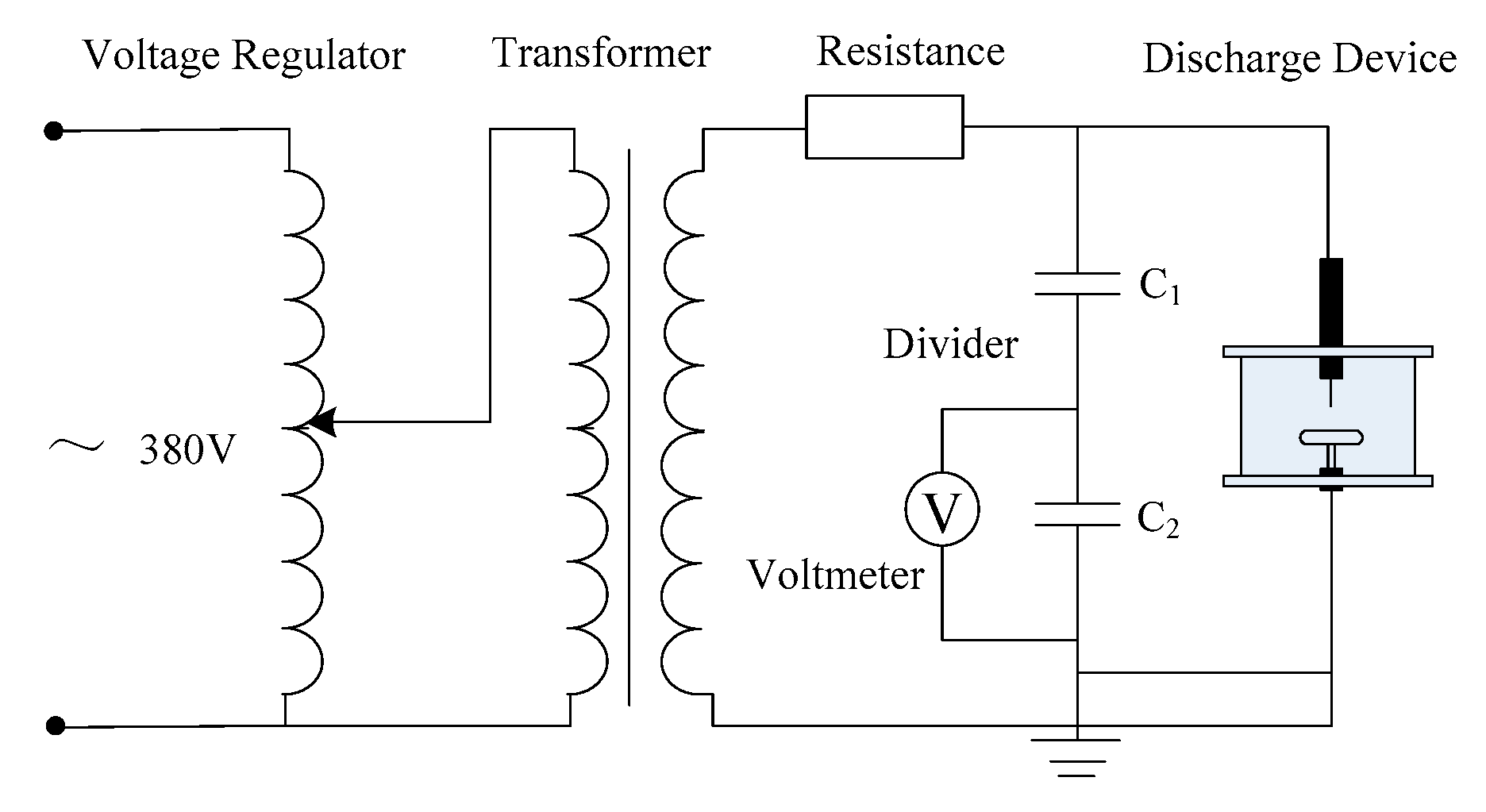
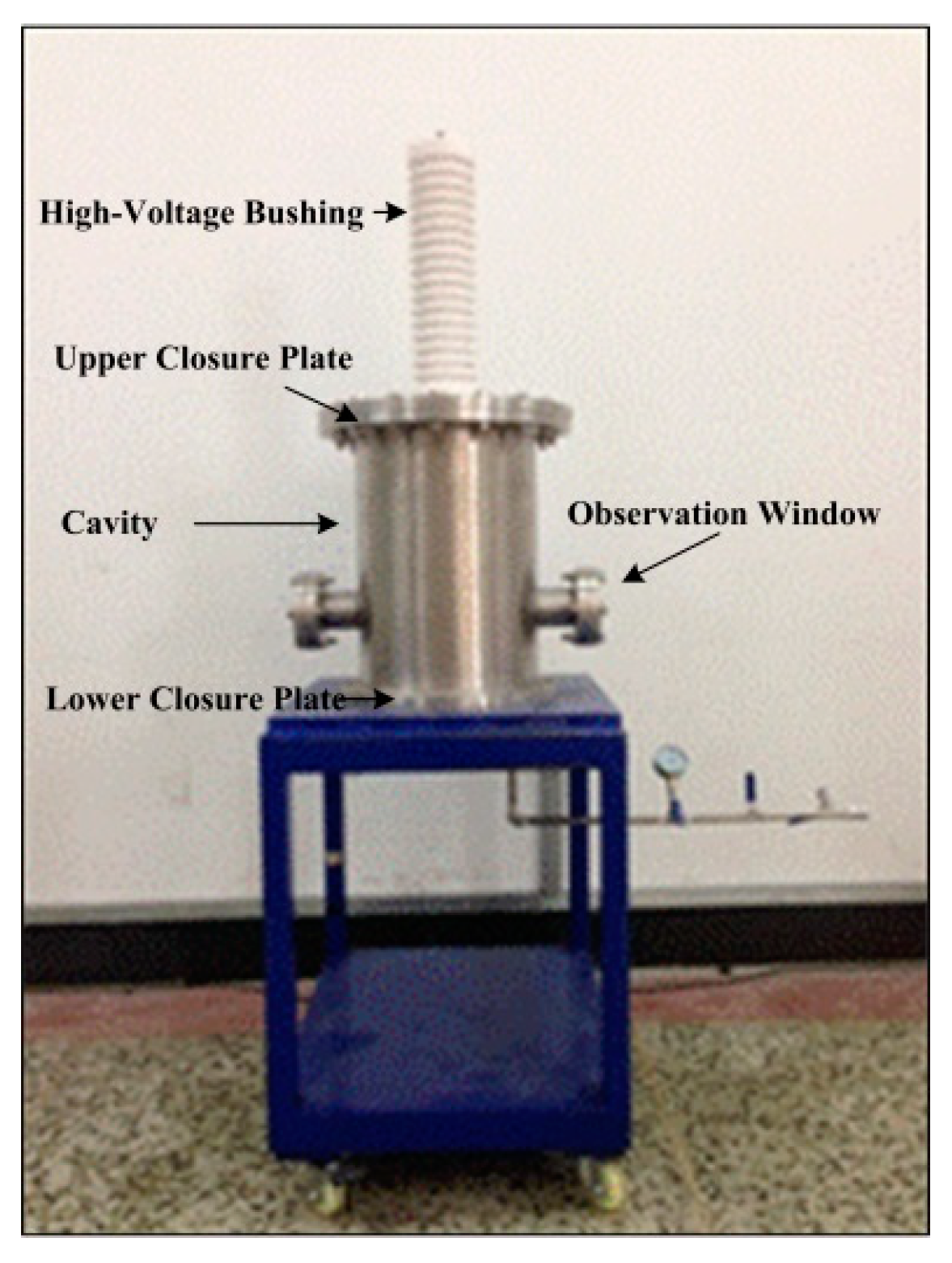

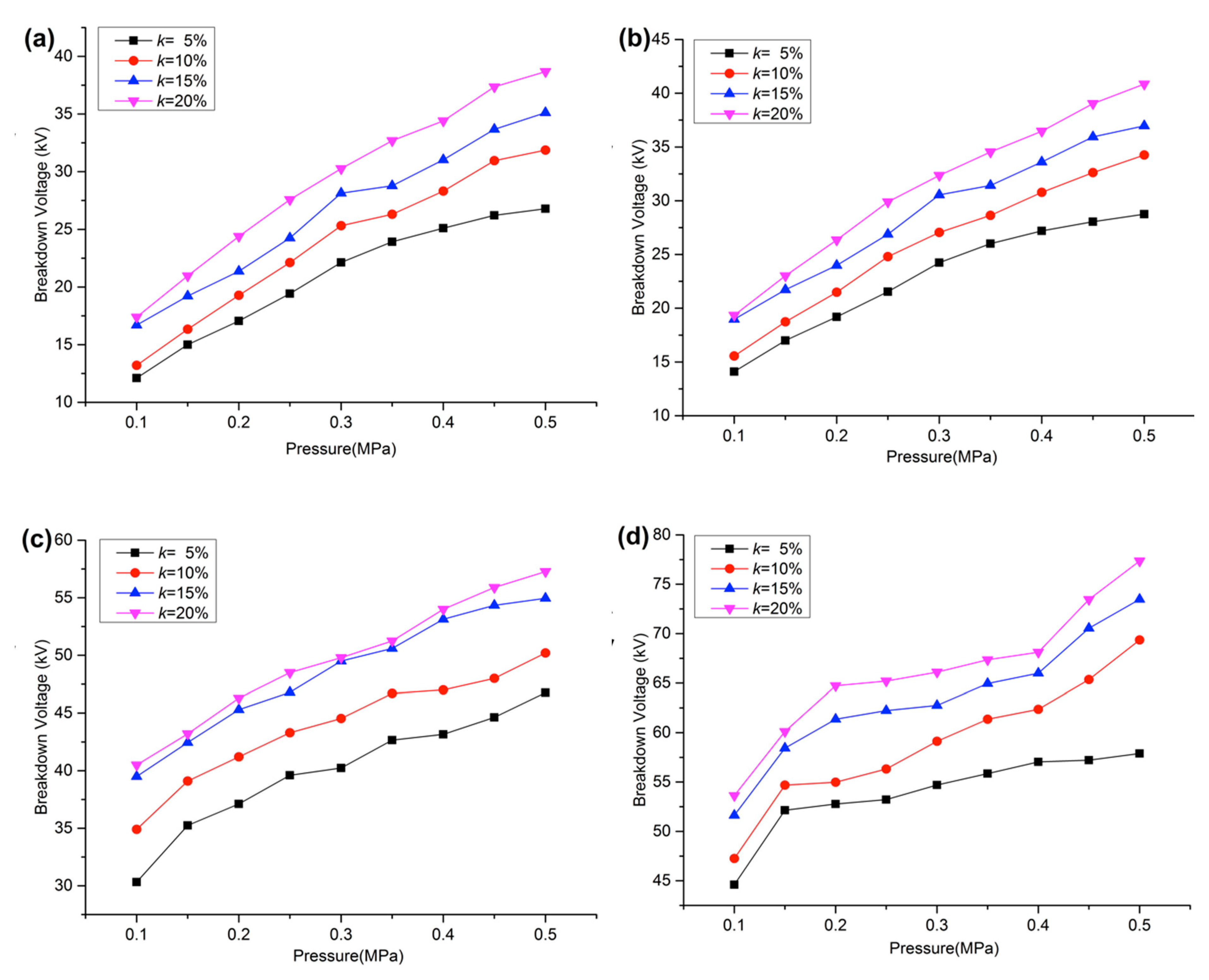
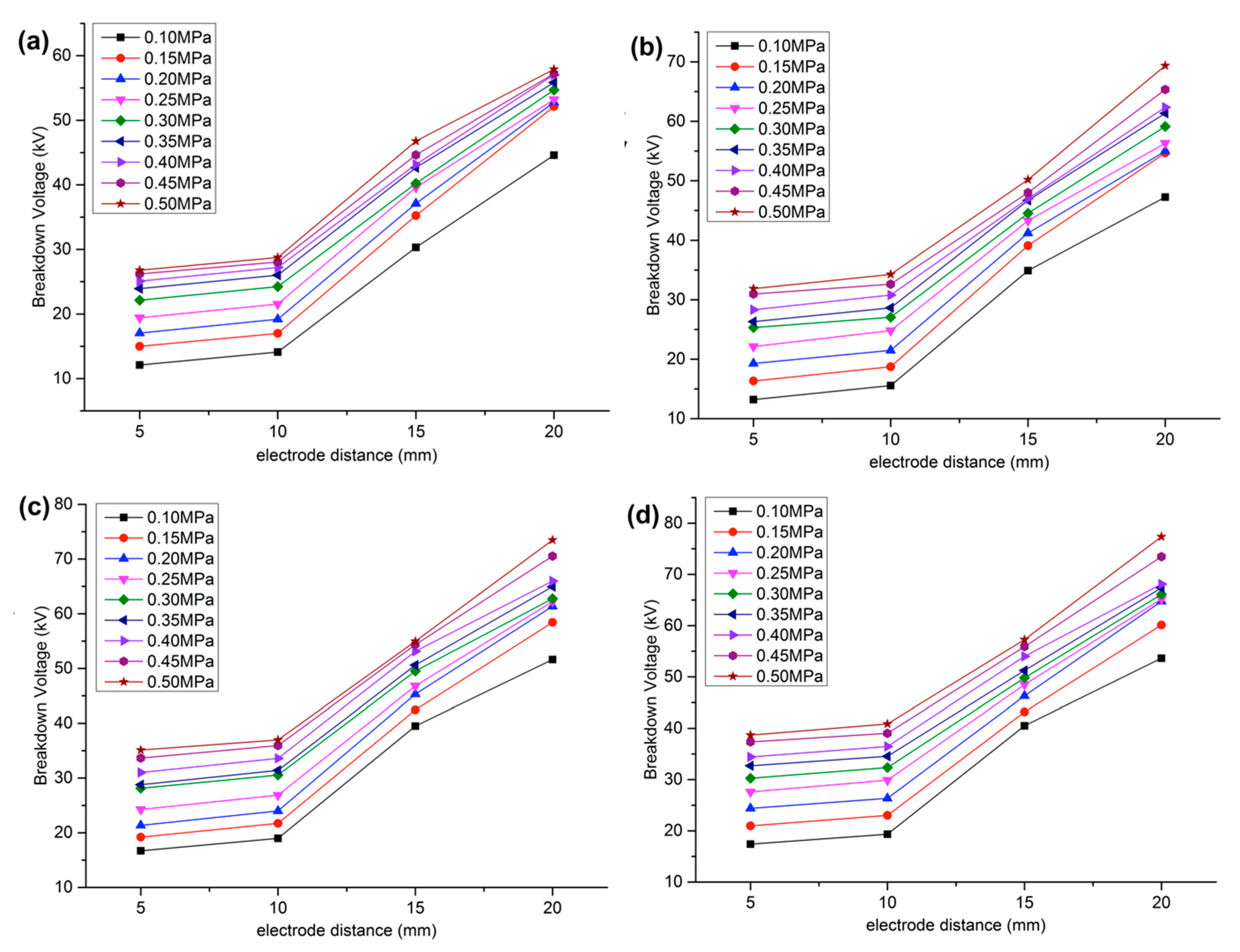
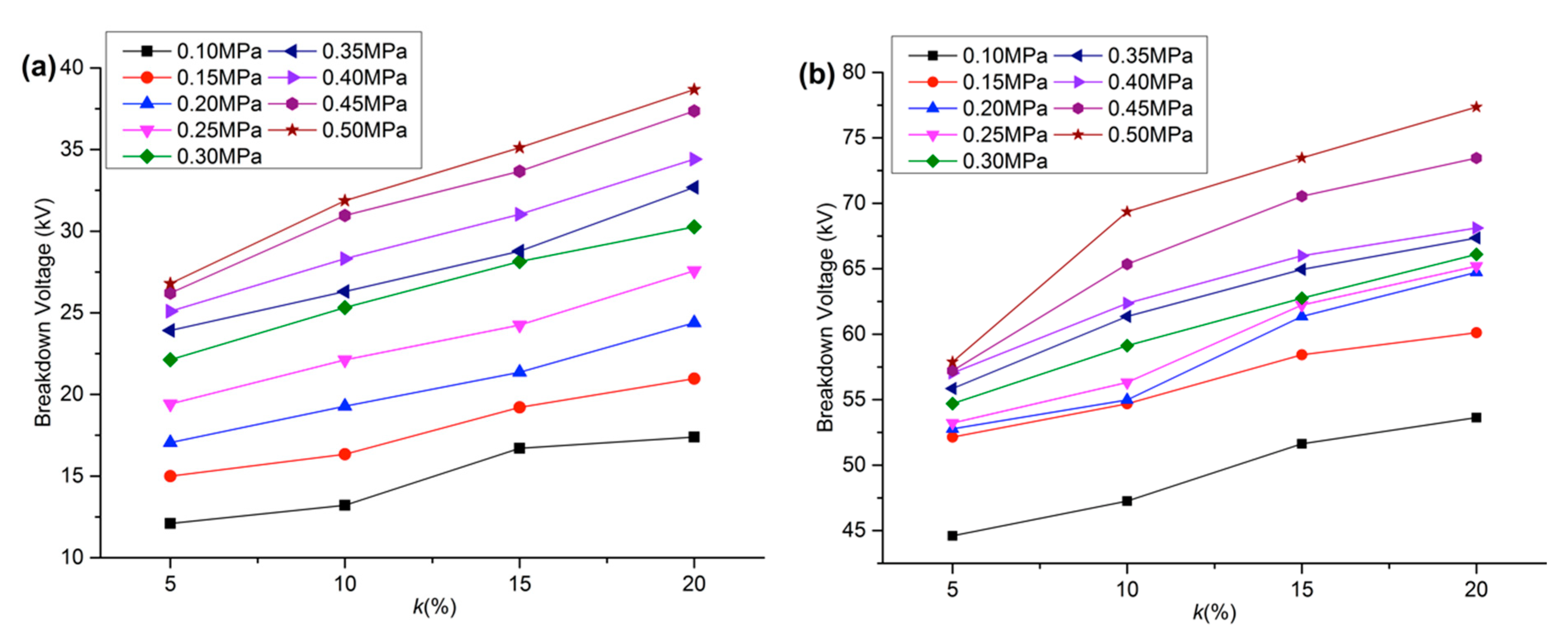
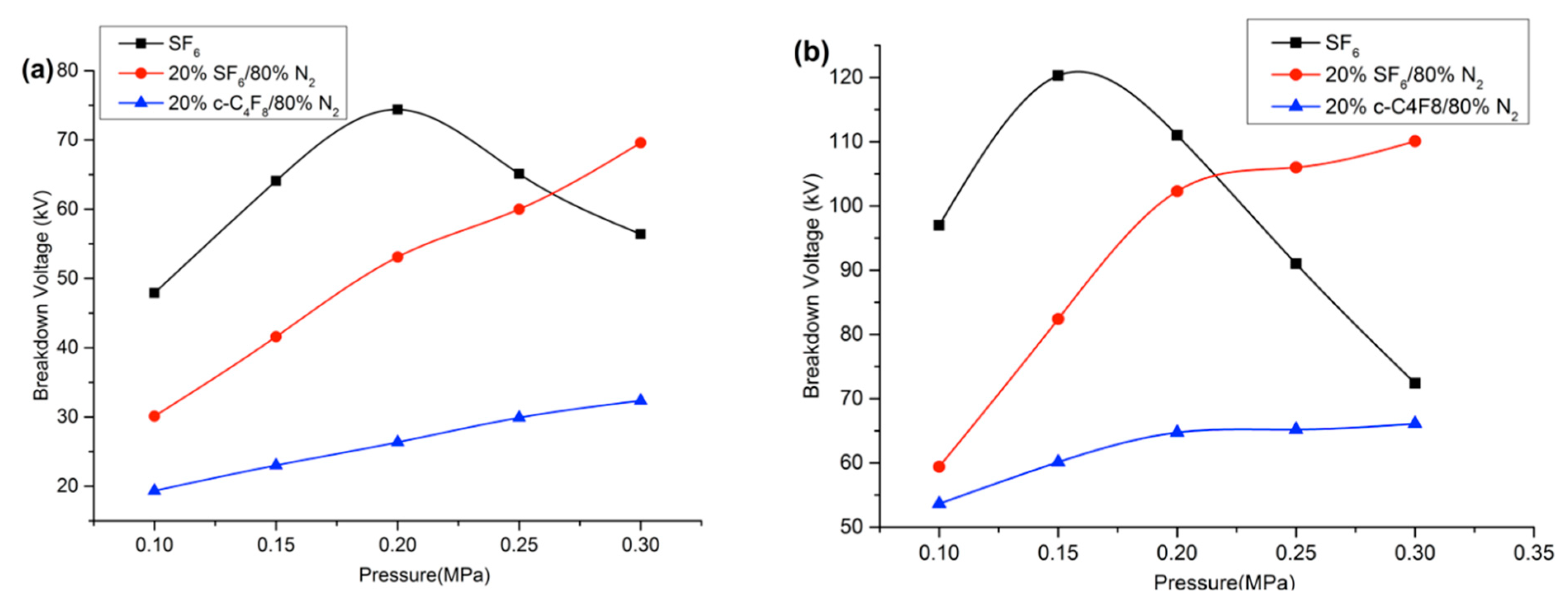
| Electrode gap /mm | 5 | 10 | 15 | 20 |
| Non-uniformity coefficients | 4.2 | 5.75 | 6.9 | 7.9 |
© 2018 by the authors. Licensee MDPI, Basel, Switzerland. This article is an open access article distributed under the terms and conditions of the Creative Commons Attribution (CC BY) license (http://creativecommons.org/licenses/by/4.0/).
Share and Cite
Lin, L.; Chen, Q.; Wang, X.; Zhang, H.; Feng, H.; Zhang, C. AC Breakdown Characteristics of c-C4F8/N2 Gas Mixtures in an Extremely Non-Uniform Electric Field. Energies 2018, 11, 3533. https://doi.org/10.3390/en11123533
Lin L, Chen Q, Wang X, Zhang H, Feng H, Zhang C. AC Breakdown Characteristics of c-C4F8/N2 Gas Mixtures in an Extremely Non-Uniform Electric Field. Energies. 2018; 11(12):3533. https://doi.org/10.3390/en11123533
Chicago/Turabian StyleLin, Lin, Qingguo Chen, Xinyu Wang, Hui Zhang, Haoran Feng, and Cong Zhang. 2018. "AC Breakdown Characteristics of c-C4F8/N2 Gas Mixtures in an Extremely Non-Uniform Electric Field" Energies 11, no. 12: 3533. https://doi.org/10.3390/en11123533
APA StyleLin, L., Chen, Q., Wang, X., Zhang, H., Feng, H., & Zhang, C. (2018). AC Breakdown Characteristics of c-C4F8/N2 Gas Mixtures in an Extremely Non-Uniform Electric Field. Energies, 11(12), 3533. https://doi.org/10.3390/en11123533





